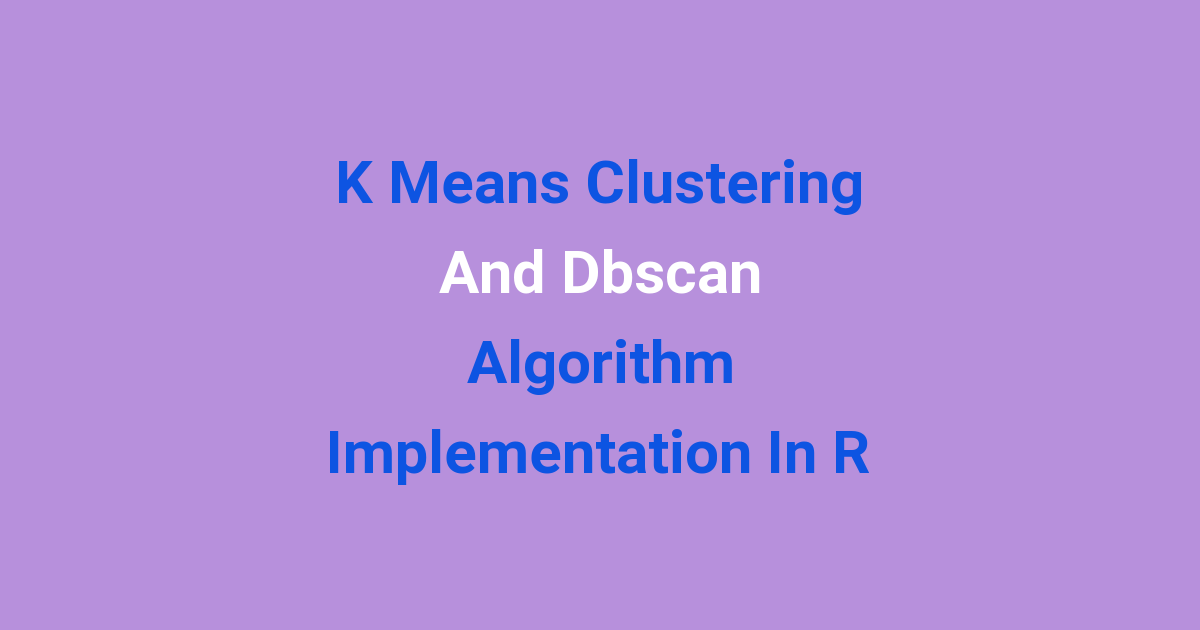Implementation of k-means clustering and DBSCAN algorithms in R.
Introduction
Welcome to my project report on the implementation of k-means clustering and DBSCAN algorithm in R. As a student pursuing a Bachelor of Technology in India, I have undertaken this project to explore these two popular clustering algorithms and their application in data analysis. The purpose of this project is to understand the working of k-means clustering and DBSCAN algorithm and to implement them in R programming language for data clustering.
Problem Statement
Clustering is a popular technique in data analysis to group similar data points together based on certain features. However, traditional clustering algorithms such as k-means can be sensitive to initial centroids and may not perform well with noisy data. On the other hand, DBSCAN is more robust to noise and can handle clusters of arbitrary shapes, but it requires setting two parameters epsilon and minPts which can be challenging. In this project, our goal is to implement k-means and DBSCAN algorithms in R and compare their performance on a given dataset.
Existing System
The existing system for clustering involves using k-means algorithm which partitions the data into k clusters based on the distance between data points and centroid. However, k-means algorithm is sensitive to initial centroids and may converge to local optima. Moreover, it assumes that clusters are spherical and of equal size which may not be true for all datasets. On the other hand, DBSCAN algorithm is more robust to noise and can handle clusters of arbitrary shapes. However, it requires setting two parameters epsilon and minPts which can be challenging.
Disadvantages
The disadvantages of using k-means algorithm include sensitivity to initial centroids, assumption of spherical clusters, and convergence to local optima. Additionally, k-means may not perform well with noisy data and is not suitable for clusters of arbitrary shapes. On the other hand, DBSCAN algorithm requires setting parameters epsilon and minPts which can be challenging and may impact the quality of clustering.
Proposed System
In this project, we propose to implement k-means clustering and DBSCAN algorithm in R programming language. By combining the strengths of both algorithms, we aim to develop a hybrid clustering approach that can handle noisy data and clusters of arbitrary shapes. Our proposed system will involve using k-means as an initialization step for DBSCAN, which can help in finding initial clusters and then refining them using DBSCAN algorithm.
Advantages
The advantages of our proposed system include robustness to noise, ability to handle clusters of arbitrary shapes, and improved performance compared to traditional clustering algorithms. By combining k-means and DBSCAN, we can leverage the strengths of both algorithms and overcome their limitations. Our proposed system can provide better clustering results in terms of accuracy and efficiency.
Features
The key features of our proposed system include:
- Implementation of k-means clustering for initial centroid selection
- Integration of DBSCAN algorithm for refining clusters
- Ability to handle noisy data and clusters of arbitrary shapes
- Improved clustering performance compared to traditional algorithms
- User-friendly interface for data input and result visualization
Conclusion
In conclusion, our project aims to implement k-means clustering and DBSCAN algorithm in R programming language to develop a hybrid clustering approach. By combining the strengths of both algorithms, we can overcome the limitations of traditional clustering algorithms and provide better clustering results. Our proposed system offers robustness to noise, ability to handle clusters of arbitrary shapes, and improved performance in clustering. Through this project, we hope to contribute to the field of data analysis and provide a valuable tool for clustering in various applications.

